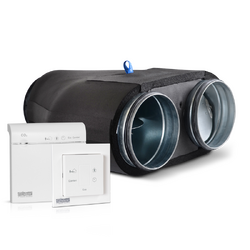
Zoning is the division of space into functional areas (zones) to suit the lifestyles and needs of the family living in the house. Zoned ventilation is a demand-controlled ventilation system (DCV) that separates home space into two or more living zones.
Zones are indicated according to homeowners' activity. Zoned ventilation provides fresh air on demand, which means when someone enters a zone, the CO2 level rises and more fresh air is needed, the system directs airflow to that zone specifically. How does the system know if there is a demand? CO2 sensors located in each zone signal to the heat recovery system when fresh air is needed in that area.
A zoned ventilation system consists of the typical ducted MVHR system (ducts, air handling unit, valves, etc.), sensors (CO2, humidity, or detection sensors), and the component that makes the division into zones possible - regulating T-piece damper.
Two distinct zones can be identified based on the lifestyles of the family members and the layout of the rooms. These zones are the night zone and the day zone. As the name implies, "day zones" are areas of your home that are occupied during the day (such as the living room). "Night zones" are areas that are occupied more at night (such as bedrooms).